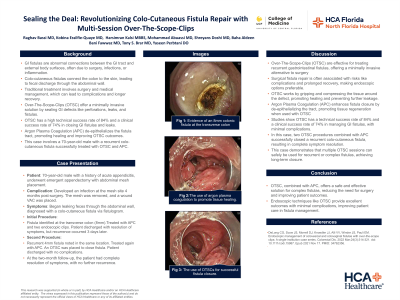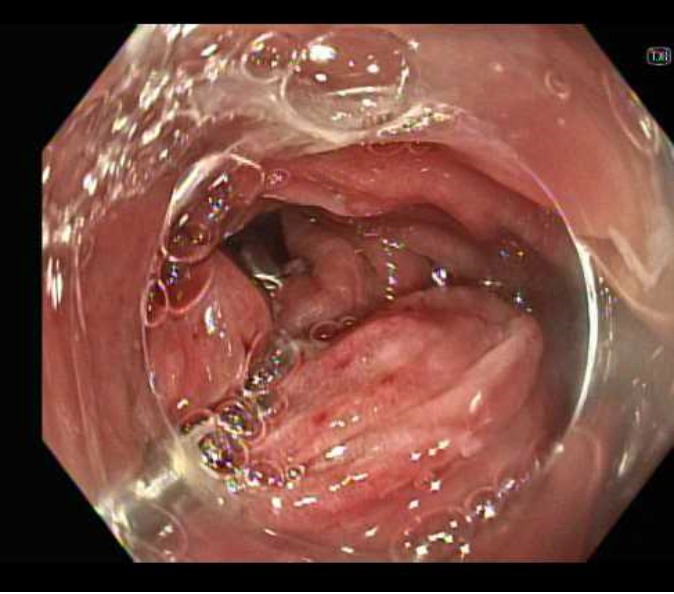Monday Poster Session
Category: Interventional Endoscopy
P2841 - Closing the Gap: Revolutionizing Colo-Cutaneous Fistula Repair With Multi-Session Over-the-Scope Clips
Monday, October 28, 2024
10:30 AM - 4:00 PM ET
Location: Exhibit Hall E

Has Audio

Raghav Bassi, MD
University of Central Florida College of Medicine
Gainesville, FL
Presenting Author(s)
Raghav Bassi, MD1, Kobina Essilfie-Quaye, MD1, Harsimran Kalsi, MBBS1, Mohammad Abuassi, MD1, Shreyans Doshi, MD2, Baha Aldeen Bani Fawwaz, MD3, Sanjeevani Tomar, MD3, Yaseen Perbtani, DO1, Tony S.. Brar, MD1
1University of Central Florida College of Medicine, Gainesville, FL; 2Wake Forest University School of Medicine, Charlotte, NC; 3AdventHealth, Orlando, FL
Introduction: Endoscopic closure of full-thickness gastrointestinal (GI) defects can be done in a minimally invasive fashion using over-the-scope-clips (OTSC) (OVESCO, Germany). OTSCs are typically used in the management of perforations, acute or chronic anastomotic leaks, and dehiscences. With recent advances in therapeutic endoscopy, OTSC has also proven to be beneficial in the closure of fistulas by digging into the GI wall and providing constant pressure on the internal fistula opening.
Case Description/Methods: A 70-year-old male with a past surgical history of emergent appendectomy with placement of an abdominal mesh presented to the emergency department. His surgery was complicated by an infection of the mesh 4 months prior to admission and he was then evaluated by general surgery during that time who removed the abdominal mesh and placed a wound VAC. Shortly after, he began leaking feces through his abdominal wall. He then underwent a fistulogram which showed an enterocutaneous fistula between the anterior abdominal wound and the large bowel. The patient was referred to our advanced endoscopy team for colonoscopic repair of the fistula. During the endoscopy an 8mm colonic fistula was noted at the transverse colon. The fistula was treated with argon plasma coagulation (APC) to allow for tissue healing, and two clips were placed for closure. The procedure was done successfully with no complications, and the patient was discharged home the same day. The patient's symptoms initially resolved, however, three days later he began passing gas and stool from the wound again. The patient then underwent another colonoscopic repair and a 4mm fistula was found in the transverse colon. This was treated with APC and closure was performed with an OTSC (Fig 3). The patient tolerated the procedure with no complications and was discharged home the next day to resume his regular diet. The patient was seen at follow-up two months later with complete resolution of symptoms.
Discussion: The use of OTSC for closure of GI leaks and fistulas is a major breakthrough in the field of advanced endoscopy. A recent systematic review revealed that the technical and clinical success rate of OTSC for the treatment of anastomosis leaks and fistula to be around 84% and 74% respectively with less than 2% of patients experiencing complications. As seen above, multiple sessions can be utilized safely and effectively to close large GI defects with the use of APC to improve healing through de-epithelialization of the fistula.

Disclosures:
Raghav Bassi, MD1, Kobina Essilfie-Quaye, MD1, Harsimran Kalsi, MBBS1, Mohammad Abuassi, MD1, Shreyans Doshi, MD2, Baha Aldeen Bani Fawwaz, MD3, Sanjeevani Tomar, MD3, Yaseen Perbtani, DO1, Tony S.. Brar, MD1. P2841 - Closing the Gap: Revolutionizing Colo-Cutaneous Fistula Repair With Multi-Session Over-the-Scope Clips, ACG 2024 Annual Scientific Meeting Abstracts. Philadelphia, PA: American College of Gastroenterology.
1University of Central Florida College of Medicine, Gainesville, FL; 2Wake Forest University School of Medicine, Charlotte, NC; 3AdventHealth, Orlando, FL
Introduction: Endoscopic closure of full-thickness gastrointestinal (GI) defects can be done in a minimally invasive fashion using over-the-scope-clips (OTSC) (OVESCO, Germany). OTSCs are typically used in the management of perforations, acute or chronic anastomotic leaks, and dehiscences. With recent advances in therapeutic endoscopy, OTSC has also proven to be beneficial in the closure of fistulas by digging into the GI wall and providing constant pressure on the internal fistula opening.
Case Description/Methods: A 70-year-old male with a past surgical history of emergent appendectomy with placement of an abdominal mesh presented to the emergency department. His surgery was complicated by an infection of the mesh 4 months prior to admission and he was then evaluated by general surgery during that time who removed the abdominal mesh and placed a wound VAC. Shortly after, he began leaking feces through his abdominal wall. He then underwent a fistulogram which showed an enterocutaneous fistula between the anterior abdominal wound and the large bowel. The patient was referred to our advanced endoscopy team for colonoscopic repair of the fistula. During the endoscopy an 8mm colonic fistula was noted at the transverse colon. The fistula was treated with argon plasma coagulation (APC) to allow for tissue healing, and two clips were placed for closure. The procedure was done successfully with no complications, and the patient was discharged home the same day. The patient's symptoms initially resolved, however, three days later he began passing gas and stool from the wound again. The patient then underwent another colonoscopic repair and a 4mm fistula was found in the transverse colon. This was treated with APC and closure was performed with an OTSC (Fig 3). The patient tolerated the procedure with no complications and was discharged home the next day to resume his regular diet. The patient was seen at follow-up two months later with complete resolution of symptoms.
Discussion: The use of OTSC for closure of GI leaks and fistulas is a major breakthrough in the field of advanced endoscopy. A recent systematic review revealed that the technical and clinical success rate of OTSC for the treatment of anastomosis leaks and fistula to be around 84% and 74% respectively with less than 2% of patients experiencing complications. As seen above, multiple sessions can be utilized safely and effectively to close large GI defects with the use of APC to improve healing through de-epithelialization of the fistula.

Figure: Fig 1: Successful placement of over-the-scope clips for fistula closure in multiple sessions.
Disclosures:
Raghav Bassi indicated no relevant financial relationships.
Kobina Essilfie-Quaye indicated no relevant financial relationships.
Harsimran Kalsi indicated no relevant financial relationships.
Mohammad Abuassi indicated no relevant financial relationships.
Shreyans Doshi indicated no relevant financial relationships.
Baha Aldeen Bani Fawwaz indicated no relevant financial relationships.
Sanjeevani Tomar indicated no relevant financial relationships.
Yaseen Perbtani indicated no relevant financial relationships.
Tony Brar indicated no relevant financial relationships.
Raghav Bassi, MD1, Kobina Essilfie-Quaye, MD1, Harsimran Kalsi, MBBS1, Mohammad Abuassi, MD1, Shreyans Doshi, MD2, Baha Aldeen Bani Fawwaz, MD3, Sanjeevani Tomar, MD3, Yaseen Perbtani, DO1, Tony S.. Brar, MD1. P2841 - Closing the Gap: Revolutionizing Colo-Cutaneous Fistula Repair With Multi-Session Over-the-Scope Clips, ACG 2024 Annual Scientific Meeting Abstracts. Philadelphia, PA: American College of Gastroenterology.
